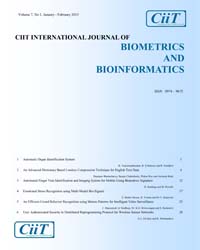Non-Cooperative Iris Recognition with Fake Identification
Subscribe/Renew Journal
Iris recognition, the ability to recognize and distinguish individuals by their pattern, is the most reliable biometric in terms of recognition and identification performance. However,performance of these systems is affected by the heterogeneous images (regarding focus, contrast, or brightness) and with several noise factors (iris obstruction and reflection) when the cooperation is not expectable from the subject. Current Iris recognition system does not deal with the noise data and substantially increase their error rates in these conditions. An Iris classification method is proposed on the segmented and normalized iris image that divides the image into six regions, followed by independent feature extraction in each region. This will provide the iris signature in terms of binary values, then that are compared with each region for the identification. Iris liveness detection also called fake identification aims to ensure that an input image sequence is from a live subject instead of an iris photograph, a video playback, a glass eye or other artifacts. However, efforts on iris liveness detection are still limited, though iris liveness detection is highly desirable. In addition to this Fake identification is also done in this paper. Fake, the original image is forged by fixing lenses over the iris portion. This can be identified by using fast Fourier transform.
Keywords
Noncooperative Iris Recognition, Iris Classification, Feature Extraction, Biometrics, Fake Identification.
User
Subscription
Login to verify subscription
Font Size
Information

Abstract Views: 228

PDF Views: 2



